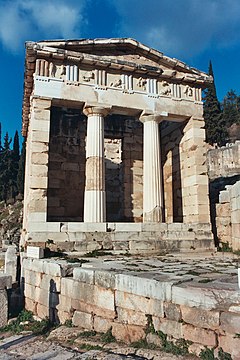Treasury of the Athenians
| Athenian Treasury | |
|---|---|
 |
|
| General information | |
| Type | Treasury |
| Architectural style | Doric |
| Location | Delphi, Greece |
| Construction started | 507 BCE to post-470 BCE |
| Completed | 502 BCE to post-470 BCE |
| Owner | Delphi Archaeological Museum |
| Height | 9.75 metres (32.0 ft) |
| Dimensions | |
| Diameter | 6.68 metres (21.9 ft) |
| Technical details | |
| Structural system | Parian marble columns |
The Athenian Treasury (Greek: Θησαυρός των Αθηναίων) at Delphi was constructed by the Athenians to house dedications made by their city and citizens to the sanctuary of Apollo. The entire treasury, including its sculptural decoration, is built of Parian marble; its date of construction is disputed, scholarly opinion ranging from 510 to 480 BCE. Pausanias mentions the building in his account of the sanctuary, claiming that it was dedicated from the spoils of the Battle of Marathon, fought in 490 BCE.
The building was excavated by the French School at Athens, led by Pierre de La Coste-Messelière, and reconstructed from 1903–1906. The structure is still visible in situ, although the metopes are reproductions; the originals are kept in the museum of Delphi.
The thirty metopes of the treasury, c. 67 cm tall and 62–64 cm wide, nine along the long sides (north and south) and six along the short (east and west), depicted the labours of Herakles and Theseus. This is the earliest surviving juxtaposition of the two.
Thesean metopes include:
Heroklean metopes include:
The platform upon which the treasury stands has a prominent inscription on its south face; it is dated internally to post-490 BCE.
ΑΘΕΝΑΙΟΙ Τ[Ο]Ι ΑΠΟΛΛΟΝ[Ι ΑΠΟ ΜΕΔ]ΟΝ ΑΚ[ΡΟΘ]ΙΝΙΑ ΤΕΣ ΜΑΡΑΘ[Ο]ΝΙ Μ[ΑΧΕ]Σ
The Athenians [dedicated this] to Apollo as first-fruits from the Persians at the Battle of Marathon.
The ancient writer and traveler Pausanias was “emphatic that the Athenian Treasury was built [meaning financed] from the spoils from the landing of the Persian general Datis at Marathon”. This means that a date later than 490 BCE, after the Battle of Marathon and accounting for time of construction, would be acceptable to Pausanias.
...
Wikipedia
